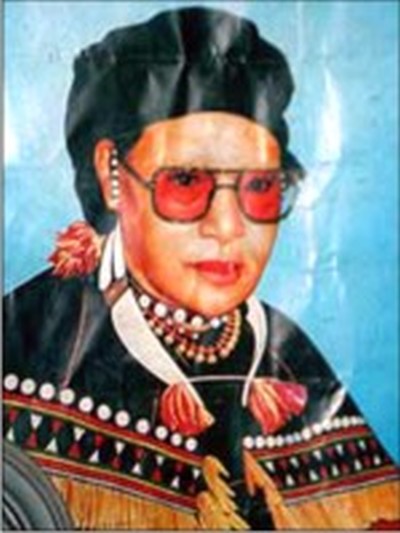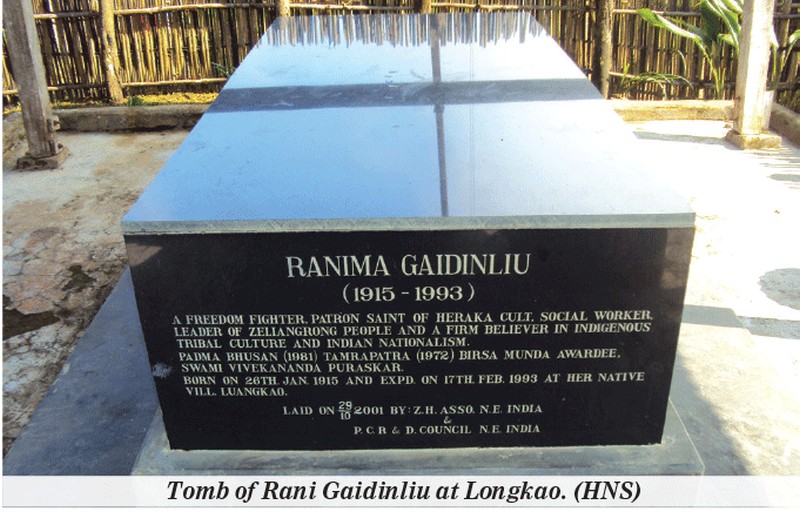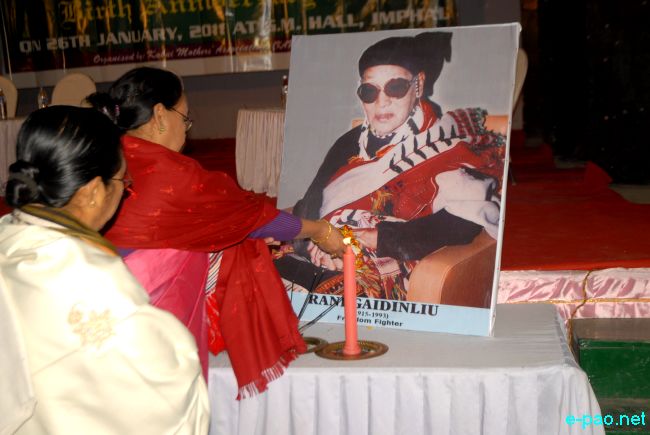
Rani Gaidinliu :: Pix - TSE
Rani Gaidinliu: Iconic Daughter of the Hills
Ajailiu Niumai *

Rani Gaidinliu :: Pix - TSE
Introduction
Rani Gaidinliu was born in 1915 and grew up as a liberated and courageous girl with mystic power. It is only much later in her life when she was a political prisoner at Shillong in 1937 when Jawaharlal Nehru visited her in the jail and was impressed that he named her as the "Rani – Daughter of the Hills" and she was widely known as Rani Gaidinliu and Rani Ma. She did not have any formal schooling since there was no educational institutions in her area during her time.
In her initial journey of spirituality, she came to know of Jadonang through dreams that lead her to visit him at Kambiron, Assam when she was 13 years. Their relationship as the master and disciple cemented and she became his trusted lieutenant.
She rose as a spiritual and political leader after the British hanged Jadonang on 29 August 1931 at Imphal, Manipur on charges of treason. Heraka is a tool of 'cultural revivalism' which attempts to act as a charm to unite these cognate tribes but could not achieve its goal as the majority have been converted into Christianity.
This period can be contextualised as an 'open moment' when different religious possibilities were available: Christianity was one possibility and it was a success. Heraka was also another possibility but did not succeed.
Challenge the British Raj
Rani Gaidinliu was deeply distressed and became aggressive after seeing the British used their authority, power and patriarchal privilege to continuously exploit and suppress her community. The British officers used even girls and women as porters to forced labour and coerced every household to pay revenue tax of Rs. 3/- per annum.
The oppressive methods of the British of using forced labour, collecting revenue taxes per house in every village, feasting at the expense of the poor villagers, constructing inter-village roads and bungalows made of bamboo and thatch roofs for Britishers to stay for a single night in the village free of cost had a profound impact on Rani Gaidinliu.

Tomb of Rani Gaidinliu at Longkao :: Pix - Hueiyen Lanpao
In 1924, the British official Mr. William Shaw visited Konphung village in Tamei sub-division, Tamenglong district, Manipur. Whenever the track to the village was rough to walk on foot, the villagers who accompanied William Shaw made a bamboo palanquin and carried him on their shoulders. Seeing such rampant oppressive practices of the British in villages, Rani Gaidinliu managed to send across the message to her people that achieving freedom from the British was a larger goal than educational, economic, cultural and social equality with men.
She understood the power of confrontation and successfully mobilised people (including girls and women) to join her army. Her act of arming girls with the dao is another example of taking from the cultural resources of her community; and this is relevant given the singular lack of political participation of Naga women in post-colonial society.
A peculiar trait of Rani Gaidinliu was engaging young 'virgin girls' as her close aids. She believed that her deity would not accept her freedom movement unless her aids are virgins. It was believed that she knew whether the young girls were virgin or not because her dream would verify it.
She had conviction that unless the girls are virgins, she would be defeated in the fights against the British. She managed to convince her followers that the British guns would turn into water while facing her. She often camped at a huge cave in Mount Kisa which could accommodate around two hundred people near Magulong village, Tamenglong district, Manipur.
Her army smuggled arms and ammunitions from Cachar, Assam by carrying it on bullock carts covered by racks and dead cows or bulls and passed over Jiri Ghat. In 1932, she was arrested and jailed as a political prisoner for 14 years. She was released after India's Independence.
Legacy and Honours
Her feminine identity as a chaste and mystic woman was critically significant during the struggle against the British as it shaped her efforts to popularise the Heraka cult and demand for the Zeliangrong homeland even after India's Independence. Under her influence, the Zeliangrong movement was strengthened.
However, she passed away in 1993 at her village without achieving her vision. She was honoured as India's freedom fighter and awarded Tamra Patra Freedom Fighter Award in 1972, Padma Bhushan in 1982, and Vivekananda Sewa Samman in 1983, Birsa Munda Award posthumously and Stree Shakti Puraskar award in 1997.
She was also honoured with a postage stamp by the Government of India in 1996. In 2010, the Hindustan Shipyard Ltd launched a shore patrol vessel named after her at Visakhapatnam, Andhra Pradesh. In 2015, the government of India launched a commemorative coin of 100 rupees and circulation coin of 5 rupees to mark her birth centenary celebrations.

96th Birth Anniversary of Rani Gaidinliu on 26 January 2011
Conclusion
Majority of the Naga tribes who were animistic earlier but have been converted to Christianity excluded her mainly due to her animistic Heraka religion. She championed the cause of independence for her cognate tribes viz; Zeme, Liangmai, Rongmei and Npuimei in Assam, Manipur and Nagaland under the Indian Union which was different from the vision of the Naga National Council (NNC), backed by majority of various Naga tribes for Naga sovereignty.
She was labelled a witch, demon possessed, sorcerer, magician and cannibal. Interestingly, Naga scholars refrained from putting such stories received through elders and others into writing; however, some youth criticised and labelled her in a derogatory language in the social media.
This was especially in 2015 after the BJP-led government proposed to construct a library-cum-memorial museum to mark Rani Gaidinliu's birth centenary in Kohima, Nagaland. She strategically combined the Heraka religion with politics to fulfil her goals in fighting against the British rulers.
Her story illustrates a rationality that could encourage marginalised women to become socio-political and spiritual leaders, questioning patriarchy and bringing about empowerment and social inclusion.